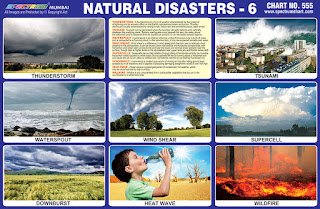 |
| Natural Disasters - 6 Chart |
Spectrum Chart - 555 : Natural Disasters - 6
1. Thunderstorm – Thunderstorms are
small, intense weather systems that make strong winds, heavy rain,
lightning and thunder. Thunderstorms can happen anywhere with two
conditions, the air near the Earth's surface must be warm and moist
and the atmosphere must be unstable. Only about 10% of thunderstorms
are thought severe. Severe thunderstorms cause high winds of more
than 56 miles per hour, hail, flash floods and tornadoes. They can
damage crops, damage the metal on cars and break windows. So, even
though thunderstorms are dangerous, they can be a great help. They
give summer water, cool the earth and clean the air.
2. Tsunami - A tsunami is a series of fast
moving waves in the ocean caused by powerful earthquakes or volcanic
eruptions. A tsunami has a very long wavelength. It can be hundreds
of kilometres long. Usually, a tsunami starts suddenly. The waves
travel at a great speed across an ocean with little energy loss. They
can remove sand from beaches, destroy trees, toss and drag vehicles,
damage houses and even destroy whole towns.
3. Waterspout - A waterspout is an intense
columnar vortex that occurs over a body of water. They are connected
to a towering cumuliform cloud or a cumulonimbus cloud. In the common
form, it is a non-supercell tornado over water. Waterspouts form
mostly in the tropics and subtropical areas. It is weaker than most
of its land counterparts.
4. Wind Shear - Wind shear is a difference
in wind speed and/or direction over a relatively short distance in
the atmosphere. Atmospheric wind shear is normally described as
either vertical or horizontal wind shear. Wind shear is a microscale
meteorological phenomenon occurring over a very small distance, but
it can be associated with mesoscale or synoptic scale weather
features such as squall lines and cold fronts. It is commonly
observed near microburstsand downbursts caused by thunderstorms.
5. Supercell – A supercell is a strong
type of thunderstorm with a thick, rotating updraft. Supercell
thunderstorms are the largest, most dangerous type of thunderstorms.
Supercells are the overall least common and have the potential to be
the most severe. Supercells are often isolated from other
thunderstorms and can dominate the local weather up to 32 kilometres
away. Supercells can produce large hail, damaging winds, deadly
tornadoes, flooding, dangerous cloud-to-ground lightning and heavy
rain.
6. Downburst – A downburst is a strong
ground-level wind system that emanates from a point source above and
blows radially, that is, in a straight line in all directions, from
the point of contact at ground level. Downbursts are created by an
area of significantly rain-cooled air that, after reaching ground
level, spreads out in all directions producing strong winds. Dry
downbursts are associated with thunderstorms with very little rain,
while wet downbursts are created by thunderstorms with high amounts
of rainfall.
7. Heat Wave – A heat wave is a
prolonged period of excessively hot weather, which may be accompanied
by high humidity, especially in oceanic climate countries. Severe
heat waves have caused catastrophic crop failures, thousands of
deaths from hyperthermia and widespread power outages due to
increased use of air conditioning. A heat wave is considered extreme
weather and a danger because heat and sunlight may overheat the human
body.
8. Wildfire - A forest fire is an
uncontrolled fire in an area of combustible vegetation that occurs in
the countryside. A forest fire differs from other fires by its
extensive size, the speed at which it can spread out from its
original source, its potential to change direction unexpectedly and
its ability to jump gaps such as roads, rivers and fire breaks. The
four major natural causes of forest fire ignitions are lightning,
volcanic eruption, sparks from rockfalls and spontaneous combustion.
They are caused by humans as well.

No comments:
Post a Comment